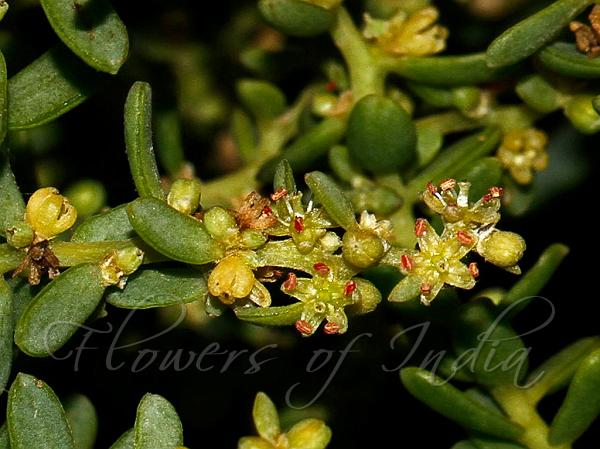|
| South-Indian Seepweed |
|

|

| File size | 223142 |
| Original date | 4/28/17 6:26 PM |
| Resolution | 1024 x 768 |
| Flash | Flash fired |
| Focal length | 100.0mm |
| Exposure time | 1/250s |
| Aperture | 13.0 |
| Focus Distance | |
| Metering Mode | Center weighted average |
| Camera make | Canon |
| Camera model | Canon EOS 7D |
| Sensor type |
|
|
|
|
Photo: |
Botanical name: Suaeda monoica Family: Amaranthaceae (Amaranth family)
Synonyms: Lerchia monoica, Salsola monoica, Schoberia monoica
Synonyms: Lerchia monoica, Salsola monoica, Schoberia monoica
South-Indian Seepweed is shrub 1.2-5 m high, trunk
often 5 cm or more thick. Leaves are linear to linear-oblong, flattened
on both sides, 13-33 x 1.5-3 mm, tip pointed or blunt, dull to bright
green, usually not glaucous, progressively shorter on flowering shoots.
Flowers are unisexual, usually quite numerous, sometimes contiguous
into dense spikes. Male flowers developing first, nearly spherical,
about 3 mm in diameter, deeply divided; anthers filling perianth; ovary
reduced to peltate-topped column with rudimentary stigmas. Female
flowers are much smaller, undivided, tightly enclosing ovary to give
appearance of naked flower, staminode-like appendages minute or absent,
stigmas 3, linear. Utricle tightly enclosed within membranous perianth,
laterally compressed. Seed vertical, 1.5-1.8 x 1-1.3 mm, glossy black.
South-Indian Seepweed is found in South India, Africa, Arabian
Peninsula.
| Identification credit: P.S. Sivaprasad | Photographed in Point Calimere Wildlife Sanctuary, Kodiakkarai, Tamil Nadu. |
• Is this flower misidentified? If yes,